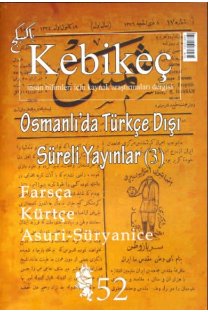Şaraplık Mayanın (Saccharomyces cerevisiae) Genetiğinden Evcilleştirme Tarihine Kısa Bir Bakış
A short look into the domestication history of the wine yeast (Saccharomyces cerevisiae) via its genetics
___
- A. Burt, V. Koufopanou, I. J. Tsai, C. M. Bergman, D. Bensasson, M. J. T. O’Kelly, A. van Oudenaarden, D. B. H. Barton, E. Bailes, A. N. Nguyen Ba, M. Jones, M. A. Quail, I. Goodhead, S. Sims, F. Smith, A. Blomberg, R. Durbin ve E. J. Louis, “Population genomics of domestic and wild yeasts”, Nature, 458: 337–341, 2009.
- A.Goffeau, B.G. Barrell, H.Bussey, R.W. Davis, B.Dujon, H.Feldmann, F.Galibert, J.D. Hoheisel, C.Jacq, M.Johnston, E.J.Louis, H.W.Mewes, Y.Murakami, P.Philippsen, H. Tettelin ve S. G. Oliver, “Life with 6000 genes,” Science, 274: 546, 563-567, 1996.
- A. Hagman,T. Sall, C. Compagno ve J. Piskur, Yeast ‘‘Make-Accumulate-Consume ’’life strategy evolved as a multi-step process that predates the whole genome duplication, PLoS ONE, 8: e68734. doi:10.1371/journal.pone.0068734, 2013.
- Belda, J. Ruiz, A. Santos, N. Van Wyk ve I. S. Pretorius, Saccharomyces cerevisiae, Trends in Genetics, 35: 956-957, 2019.
- B. Dunn, C. Richter,D. J. Kvitek,T. Pugh ve G. Sherlock, “Analysis of the Saccharomyces cerevisiae pan-genome reveals a pool of copy number variants distributed in diverse yeast strains from differing industrial environments.” Genome Res. 22: 908–924, 2012.
- C. Hitz, K. Karra, R. S. Nash,S. Weng, E. D. Wong, P. Lloyd, M. S. Skrzypek,S. R. Miyasato, M. Simison ve J. M. Cherry, “The reference genome sequenceof Saccharomyces cerevisiae: Then and now,” G3 (Bethesda), 4: 389-398, 2014.
- D. Cavalieri, P. E. McGovern,D. L. Hartl,Robert Mortimer ve M. Polsinelli, “Evidence for S. cerevisiae fermentation in ancient wine,” J. Mol. Evol., 57: S226–S232, 2003.
- G. H. Fleet, S. Lafon-Lafourcade ve P. Ribereau-Gayon, “Evolution of yeasts and lactic acid bacteria during fermentation and storage of Bordeaux wines,” Appl. Environ. Microb., 48: 1034–1038,1984.
- G. Liti, D. M. Carter, A. M. Moses, J. Warringer, L. Parts, S. A. James, R. P. Davey, I. N. Roberts, G. A. Cromie, K. E. Hyma,C. L. Ludlow, C. Garmendia-Torres,T. L. Gilbert, P. May, A. A. Huang,A. M. Dudley ve J. C. Fay, “Genomic sequence diversity and population structure of Saccharomyces cerevisiae assessed by RAD-seq.”, G3 (Bethesda, Md.), 3: 2163–2171, 2013.
- H. Csoma, N. Zakany, A. Capece, P. Romano ve M. Sipiczki, “Biological diversity of Saccharomyces yeasts of spontaneously fermenting wines in four wine regions: Comparative genotypic and phenotypic analysis,” International Journal of Food Microbiology, 140: 239–248, 2010.
- J. Bing, P.-J. Han, W.-Q. Liu, Q.-M. WangveF.-Y. Bai “Evidence for a Far East Asian origin of lager beer yeast,” Current Biology, 24: R380-1. doi: 10.1016/j.cub.2014.04.031, 2014.
- J. C. Fay ve J. A. “Benavides, Evidence for domesticated and wild populations of Saccharomyces cerevisiae,” PLoS Genetics, 1: 66–71, 2005.
- J. E. Perez-Ortin, A. Querol,S. Puig ve E. Barrio, “Molecular characterization of a chromosomal rearrangement involved in the adaptive evolution of yeast strains,” Genome Res., 12:1533–39, 2002.
- J. Piskur, E. Rozpedowska, S. Polakova, A. Merico ve C. Compagno, “How did Saccharomyces evolve to become a good brewer?”, Trends in Genetics, 22: 183-186, 2006.
- M. Novo, F. Bigeya, E. Beynea, V. Galeotea, F. Gavoryb, S. Malletc, B. Cambona, J-L. Legrasd, N. P. Jolly, C. Varela ve I. S. Pretorius, “Not your ordinary yeast: non- Saccharomyces yeasts in wine production uncovered,” FEMS Yeast Res.,14: 215–37, 2014.
- P. Almeida, R. Barbosa, P. Zalar, Y. Imanishi, K. Shimizu, B. Turchetti, J.-L. Legras, M. Serra, S. Dequin, A. Couloux, J. Guy, D. Bensasson, P. Gonçalves ve J. P. Sampaio, “A Population genomics insight into the Mediterranean origins of wine yeast domestication,” Molecular Ecology, 24: 5412–5427, 2015.
- P. E. McGovern L. Donald ve L.J.E. Glusker LJE. “Neolithic resinated wine,” Nature, 381: 480–481, 1996.
- P. McGovern, M. Jalabadze, S. Batiuk, M. P. Callahan, K. E. Smith, G. R. Hall, E. Kvavadze, D. Maghradze, N. Rusishvili, L. Bouby, O. Failla, G. Cola, L. Mariani, E. Boaretto, R. Bacilieri, P. This, N. Wales ve D. Lordkipanidze, “Early Neolithic wine of Georgia in the South Caucasus,” PNAS, 13: E10309-E10318, 2017.
- P. Winckerb, S. Casaregolac ve S. Dequina, “Eukaryote-to-eukaryote gene transfer events revealed by the genome sequence of the wine yeast Saccharomyces cerevisiae,” EC1118, PNAS, 106: 16333–16338, 2009.
- S. Marsit, A. Mena,F. Bigey,F.-X. Sauvage, A. Couloux,J. Guy, J.-L. Legras,E. Barrio,S. Dequin ve V. Galeote, “Evolutionary advantage conferred by an Eukaryote-to- Eukaryote gene transfer event in wine yeasts,” Molecular Biology and Evolution, 32: 1695– 1707, 2015.
- S. Marsit ve S. Dequin, “Diversity and adaptive evolution of Saccharomyces wine yeast: a review,” FEMS Yeast Research, 15: 1-12, 2015.
- V. Galeote, M. Novo, M. Salema-Oom, Christian Brion, E. Valério, P. Gonçalves ve S. Dequin, “a horizontally transferred gene in the Saccharomyces cerevisiae EC1118 wine yeast strain, encodes a high-affinity fructose/ H+ symporter, Microbiology,” FSY1 156: 3754– 3761, 2010.
- ISSN: 1300-2864
- Yayın Aralığı: 2
- Başlangıç: 1995
- Yayıncı: Mehtap Yüksel
Vatanına Hürmet Eden İçki İçmez: Osmanlı Men-i Müskirat Cemiyeti ve Nizamnamesi
İran’da Mirza Melkom Han’ı Hatırlamak*
Reji Dönemi Tütün Kaçakçılığının Toplumsal Anlamı ve Temsilleri*
Şaraplık Mayanın (Saccharomyces cerevisiae) Genetiğinden Evcilleştirme Tarihine Kısa Bir Bakış
Sokak Bir Öncü “San’at Mecmuası” (İstanbul - Mart/Nisan 1940)
Afyonun Japonya Serencamı ve Japonya’nın Afyon ile İmtihanı (1853-1895)
Elif YENEROĞLU, Onur KINLI, Merve DEMİRKAYA
Türkiye’de Veteriner Hekimliği Eğitiminin Kurucusu Godlewsky’e Verilen Nişan-ı Zişan*
Haşhaş, Afyon, Opioidler, Opiatlar Tarihi
Dr. Haçig Boğosyan ve Turkio Hagalkolagan Ingeragtsıtyun [Türkiye Anti-Alkolikler Birliği]
